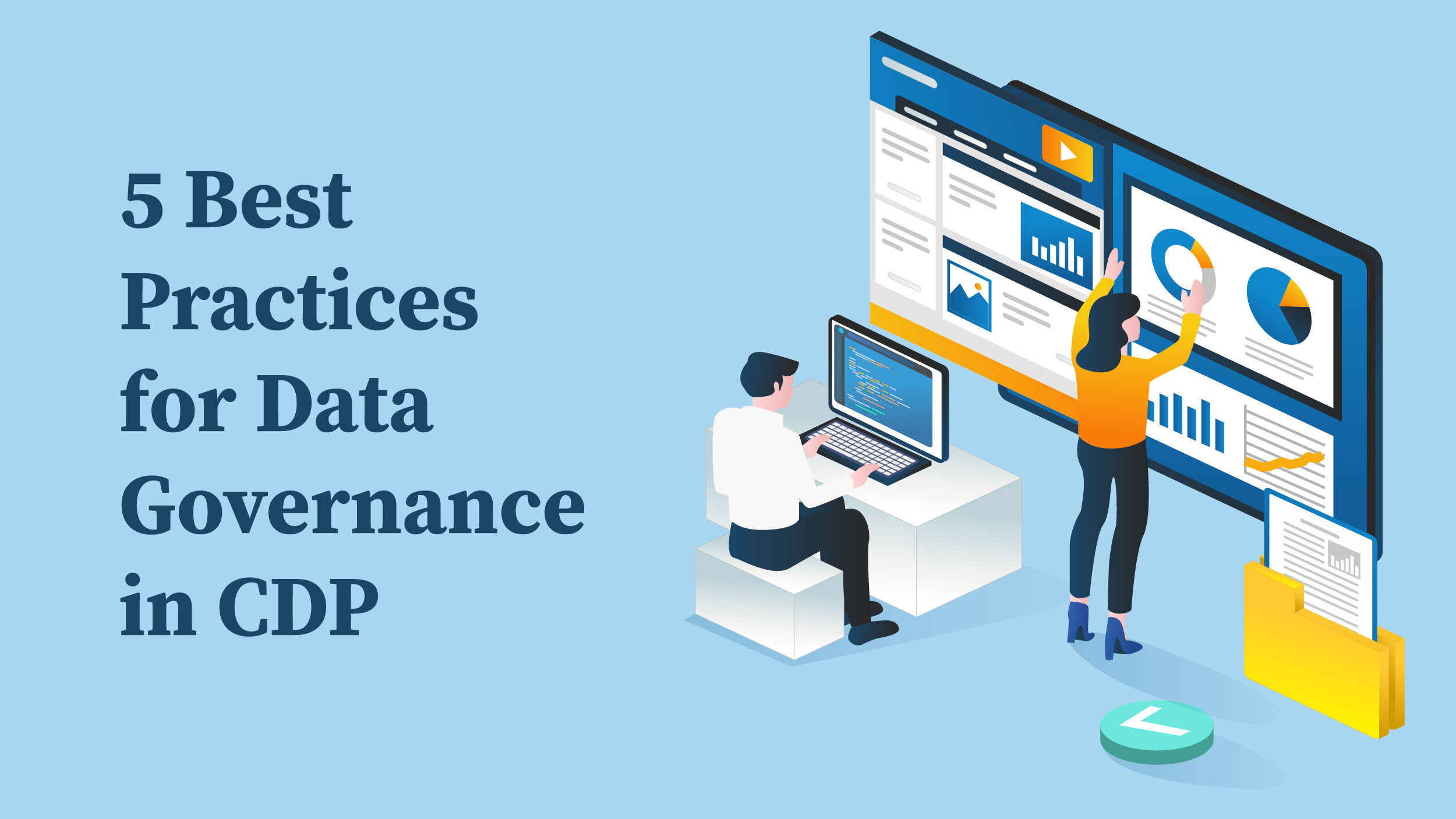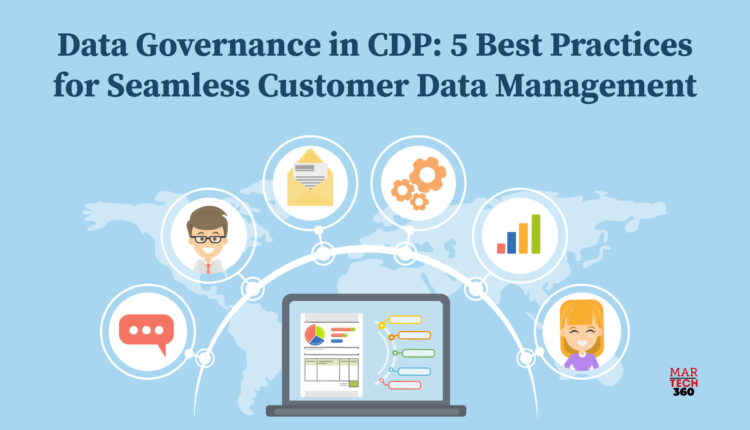Data inconsistency affects 83% of businesses, according to an IBM survey. This implies that most data-driven businesses rely on inaccurate data when making judgments.
Companies may make better decisions by focusing on the quality of data and making sure they employ clean data, and they’ll notice the difference in their bottom line.
Gathering data can be quite perplexing, which is why these companies have inaccurate data to begin with. Proper governance in the customer data platform is the solution.
It is advisable to adhere to the best practices while managing a data governance program to ensure that it is effective and efficient.
In this article, we’ll look at the five best data governance in CDP practices to follow to ensure that your business doesn’t get stuck in a loop. Before going any further, let’s first understand the basics, shall we?
What is Data Governance in CDP?
Data governance refers to the procedures and methods used to manage and guarantee the accuracy, integrity, and compliance of customer data within the platform.
Basically, the first rule of successful customer data management is data governance since it will assist you in deciding what data you can acquire and how you can collect it. Additionally, data governance will maintain employee alignment with regard to your customer data management strategy.
There are three components to every data governance strategy:
- Alignment: In this step, your company’s customer data collection procedure is standardized.
- Validation: This step makes sure that every piece of data is being gathered correctly.
- Enforcement: This guarantees that any modifications to data collection will follow the necessary procedures, resulting in the acquisition of accurate and valuable data.
The end result of your data governance strategy will be a tracking plan or data dictionary, which clearly explains every piece of data that you’re collecting, who is using it, what it’s being used for, and who owns it.
5 Best Practices for Data Governance in CDP
 Now that we know what data governance in CDP means, let’s have a look at the top practices to make sure your business stays ahead of the competition.
Now that we know what data governance in CDP means, let’s have a look at the top practices to make sure your business stays ahead of the competition.
-
Gather All Data
Without a thorough understanding of your organization’s data, it is difficult to create an effective data governance process.
The best place to start when implementing data governance across your organization is by understanding the scope of your data and where it is located. This process can be aided by tools like Data Discovery, which can provide you with the ideal foundation from which you can create a structure that works. According to estimates, your organization could lose up to 30% of its annual income due to the consequences of faulty data.
All data, including metadata and unstructured data from SaaS apps, collaborative tools, and other shared files, needs to be taken into account.
-
Categorize
Once you have a good understanding of your data’s volume, categories, sensitivity, and storage, it’s time to get it organized. This is where data governance in CDP comes in. Organizations should define and document their data interpretation, classification, and processing procedures based on sensitivity levels and policies in place. This will help to ensure that all data is handled consistently and securely across the organization.
Also, keep in mind the data’s business context. In this approach, your catalog may be made intuitive to use by applying the taxonomy and business rules that apply to your data.
This data catalog serves two purposes.
- It makes it simple for everyone in the business to access data, which eliminates a lot of misunderstandings about where data is kept.
- It serves as a master locker, establishing guidelines for access for various seniority levels and responsibilities and disseminating information based on need-to-know. A well-functioning data governance system is built on having this crystal-clear data organizational structure.
-
Manage your data throughout its lifecycle
Your data flows through your organization, so it’s important to manage it effectively at every stage. This includes developing policies and processes for data acquisition, storage, transfer, and disposition.
When developing these policies and processes, consider how they interact with each other. Breaking up the data governance process into smaller, more manageable tasks can help you build a cohesive strategy.
It’s also important to establish data stewards for each stage of the lifecycle across departments. Data stewards are responsible for ensuring that data governance policies and processes are followed and that any violations are addressed promptly.
-
Establish privacy and data security as standard practices
When thinking about data, two of the most crucial considerations are privacy and security. Your data governance in CDP policy should require that you maintain compliance with privacy laws and have the required security measures. The use of AI in marketing, customer service, and technical assistance has raised concerns in the minds of nearly 82% of consumers, who think they are extremely concerned about the potential for this to breach their online data privacy.
When creating processes for the data in your company, keep data privacy in mind, including checks and balances in your privacy rules. This makes it easier to comply with privacy laws and manage different types of data.
Implement security controls to lower risk while supporting business as usual. Be aware of your security requirements to prevent incompatible software and redundant efforts.
-
Get business support
Get the buy-in of important departmental stakeholders by presenting the business case for data governance to them. This will help ensure that these guidelines are disseminated and adhered to in all necessary parts of the organization. Having data stewards across your organization is crucial, regardless of whether you decide to have a centralized or decentralized structure for your data governance program.
The difference between a fantastic data governance policy on paper and one that works in practice is these data stewards.
Final Verdict on Data Governance in CDP
 Organizations can guarantee the quality, security, and compliance of their consumer data by putting strong data governance procedures into place. Establishing guidelines for data collection, storage, access, and use is known as data governance. It also includes tasks like data classification, protection, privacy, security, and compliance with legal requirements. The integrity and reliability of consumer data may be maintained by enterprises with strong data governance, promoting improved decision-making, enhancing customer experiences, and laying the groundwork for long-term success in the data-driven era. Prioritizing data governance in CDP enables firms to properly and morally leverage their data assets, eventually spurring business success and boosting customer confidence.
Organizations can guarantee the quality, security, and compliance of their consumer data by putting strong data governance procedures into place. Establishing guidelines for data collection, storage, access, and use is known as data governance. It also includes tasks like data classification, protection, privacy, security, and compliance with legal requirements. The integrity and reliability of consumer data may be maintained by enterprises with strong data governance, promoting improved decision-making, enhancing customer experiences, and laying the groundwork for long-term success in the data-driven era. Prioritizing data governance in CDP enables firms to properly and morally leverage their data assets, eventually spurring business success and boosting customer confidence.


Comments are closed.